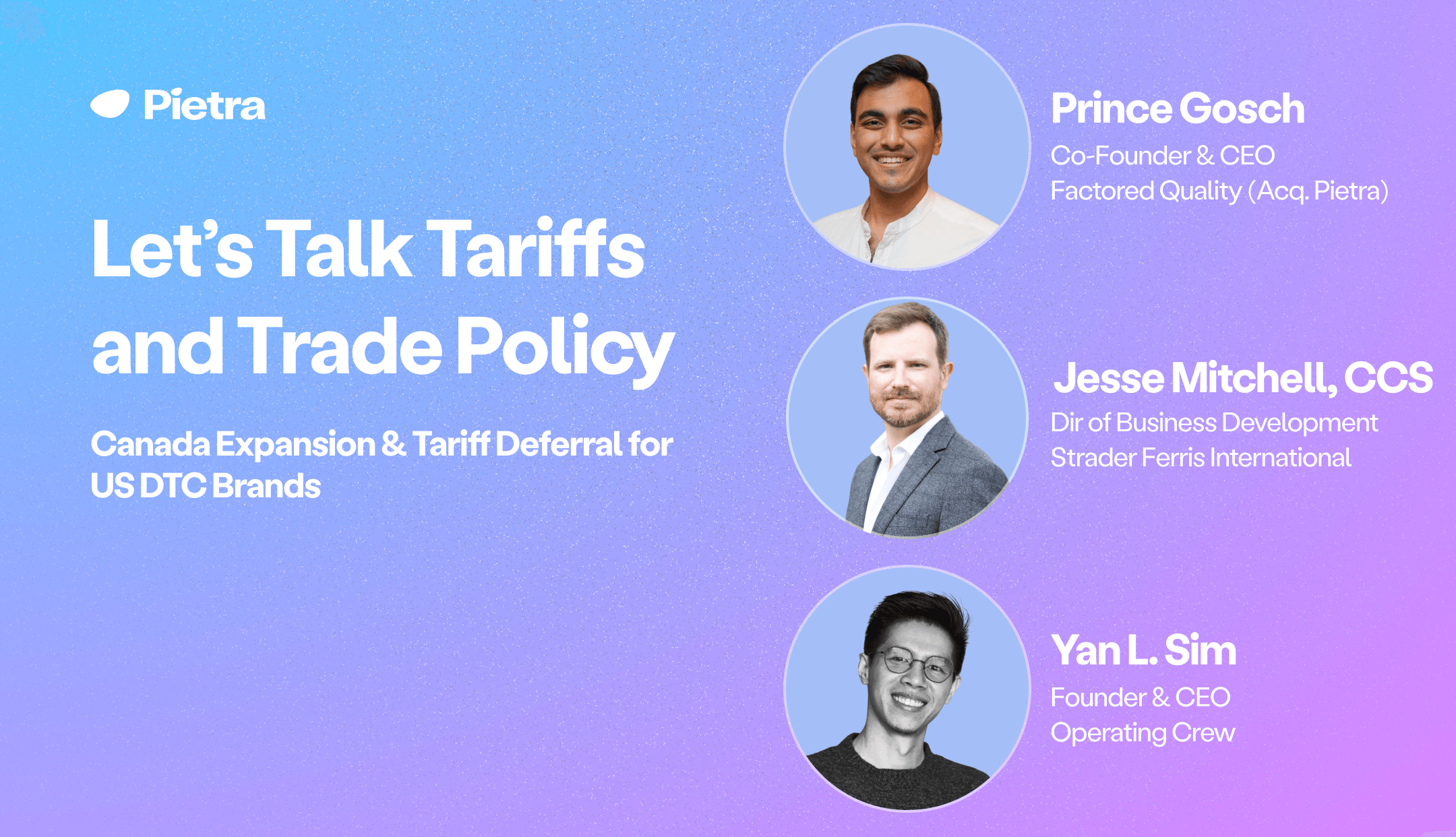
U.S. direct-to-consumer (DTC) brands are facing a growing challenge: tariffs on Chinese imports have surged past 145%, with more changes expected as Section 321 de minimis relief winds down. For brands that rely on Chinese manufacturing to maintain competitive pricing and healthy margins, these changes can be destabilizing.
To help founders and operators navigate this moment, Pietra hosted a live webinar with Yan Sim, founder of Operating Crew, and Jesse Mitchell, Director of Business Development at SFI Group. The conversation explored how U.S. brands can use Canada as a dual-purpose strategy: a way to defer duties and access new e-commerce markets.
Watch the full webinar below or read on for a detailed breakdown of the strategies, quotes, and key takeaways.
Why Tariffs Are Reshaping DTC Logistics
Many DTC brands rely on Chinese manufacturing for high-margin product categories like apparel, accessories, home goods, and electronics. But the sharp rise in tariffs has changed the economics almost overnight.
"I've talked to brands where it's literally cheaper to burn their inventory than bring it in at a 145% tariff."
— Yan Sim, Operating Crew
In some cases, brands have had to consider delaying launches, canceling purchase orders, or seeking alternative suppliers—none of which are ideal when timelines are tight and Q4 is around the corner.
The biggest challenge isn't just cost; it's unpredictability. Tariff structures are evolving quickly, and a shipment that was viable last month may become prohibitively expensive by the time it lands.
Canada as a Strategic Cross-Border Hub
While bonded warehouses and foreign trade zones (FTZs) offer some relief, the reality is that space is limited, setup is complex, and many DTC brands lack the resources to manage that infrastructure.
This is where Canada enters the picture as a flexible alternative.
"Getting set up in Canada is surprisingly easy for U.S. companies. With an NRI number and a customs broker, you can be live in 3 to 4 weeks."
— Jesse Mitchell, SFI Group
The Canadian market itself is also compelling. With over $80B CAD in annual e-commerce volume, it's an opportunity for brands to drive revenue while positioning inventory just outside the U.S.
When brands import into Canada and re-export to the U.S., they can defer duties until withdrawal. That means brands can keep inventory nearby, fulfill Canadian orders directly, and only pay U.S. tariffs when they absolutely need to.
Bonded Warehouses vs. FTZs vs. Canada
Brands often ask: what’s the difference between bonded warehouses, FTZs, and using Canada? While they all offer some form of duty relief, the nuances matter.
A bonded warehouse lets you bring goods into the U.S. without clearing customs immediately. You only pay duties when the goods leave the warehouse. Critically, the duty rate is based on the withdrawal date.
An FTZ, on the other hand, calculates duties based on the date goods enter the zone, which can lock brands into today’s high rates.
"In today’s environment, locking in at 145% is a losing bet. If you can defer and wait for a better rate, you should."
— Yan Sim, Operating Crew
The Canada strategy functions similarly to a bonded warehouse—goods are nearby but haven’t cleared U.S. customs, so duties aren’t due until re-export.
The 3PL Factor: Picking the Right Partner
Choosing the right logistics partner is just as important as where inventory is stored. Many DTC brands sell across multiple channels: their own website, Amazon, retail dropship programs, and brick-and-mortar retailers like Target or Costco.
"A lot of 3PLs say they do wholesale. But are they doing one Target order every quarter—or five every week?"
— Yan Sim, Operating Crew
The right 3PL should understand routing guides, tight turnaround times, and the difference between e-commerce fulfillment and retail compliance.
Mitchell adds that brands often outgrow their current 3PL before they realize it.
"When you're small, you tolerate slower response times. But once you're shipping 5,000 orders a month, you need a partner who can move fast and communicate clearly."
— Jesse Mitchell, SFI Group
Looking for a 3PL that integrates directly with your sourcing and order management? Pietra Fulfillment offers modern warehousing and logistics built specifically for DTC brands.
Getting Started in Canada: A Step-by-Step Playbook
If you're exploring a Canadian setup, here’s how to get started:
- Apply for a Non-Resident Importer (NRI) business number
- Partner with a Canadian customs broker (like SFI Group)
- Choose a 3PL or warehouse that integrates with your tech stack
- Start by sending your top-performing SKUs—don’t overcommit
- Fulfill Canadian orders directly, re-export to the U.S. as needed
- Track savings and reallocate budget to growth
This approach gives brands flexibility: they’re not locked into paying duties upfront, and they’re positioned to capture Canadian demand.
Final Thoughts: Think Strategically, Not Reactively
Tariffs may shift again in six months, or they may get worse. That’s out of your control. But your logistics strategy isn’t.
"We never recommend reacting to short-term noise. But in this case, you get the short-term savings and the long-term market access."
— Yan Sim, Operating Crew
Brands that invest now in more flexible, border-smart operations will be better positioned to withstand volatility—and capitalize on it.
Ready to Start?
Pietra helps DTC brands source products, find global factories, fulfill orders, and expand into new markets—without the typical complexity and costs.
Whether you're just starting out or scaling fast, Pietra is the all-in-one platform for modern e-commerce operations.
Explore Pietra's tools and start for free today.
Learn more about:


